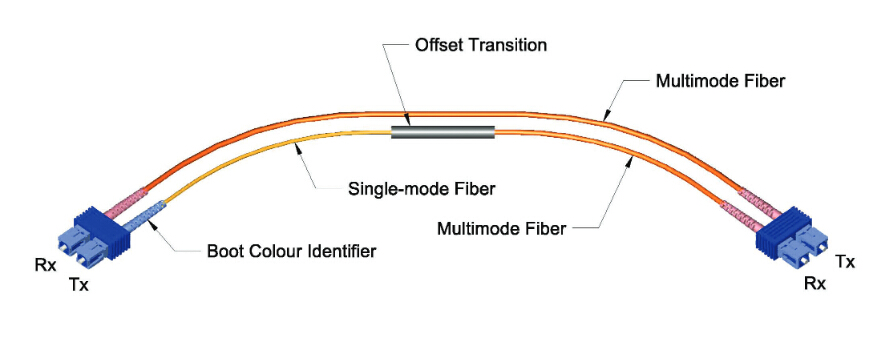December 23, 2016
As we all know, fiber optic cable jumper plays an important role in Ethernet network connection, which becomes more and more diversified to satisfy the different connection requirements in recent years. For instance, standard fiber patch cable like single mode patch cable and multimode patch cable, special fiber patch cable like mode conditioning patch cable and bend insensitive patch cable, etc. Among these various fiber patch cables, mode conditioning patch cable has been one of the most popularly used fiber patch cable due to its unique features and advantages, which will be introduced in the following text.
Mode conditioning patch cable is a special kind of duplex fiber patch cable that consists of two fibers, a conditioned fiber and a non-conditioned fiber, capped at either end with connectors. In the conditioned fiber, a single mode fiber and a multimode fiber are fusion spliced in an offset manner, with a precise core alignment and angle, protected by a black over-wrap. While in the non-conditioned fiber, there is only a length of multimode fiber. To get a better understand of its structure, you can take the following figure as reference.

As shown in the figure above, there are two multimode fibers in one end, and a multimode and single mode fiber in the opposite end. The end with two multimode fibers is designed to connect the cable plant, while the other end connects to the transceiver equipment with the single-mode leg linking to the transmit side. Hence, light signal can be launched on to the multimode fiber in the conditioned one at a specific angle, giving the patch cable its mode conditioning property. Besides, it is worth mentioning that this kind of fiber optic cable is fully compliant with IEEE 802.3z application standards.
As far as our information goes, 1310nm long wave signal is always transmitted through single mode patch cable for 1000BASE-LX transmission as a cost effective solution. However, if the mentioned above transmission utilizes multimode patch cable, it will cause a phenomenon known as DMD (differential mode delay). In simple words, if the same signal is carried to a multimode patch cable, there will be multiple signals created in the multimode patch cable that may make transmission errors to some extent.
In order to solve this problem, mode conditioning patch cable is put forward that utilizes an offset between the single-mode fiber and multimode fiber to eliminate transmission errors, allowing for 1000BASE-LX signal transmission through multimode patch cable. For example, when 1000BASE-LX routers and switches are installed into existing multimode cable plants, mode conditioning patch cable is highly recommended to adapt the single-mode output of 1000BASE-LX transceivers to a multimode cable network.
After knowing the feature and advantage of mode conditioning patch cable, do you also consider using mode conditioning patch cable to finish the conversion from single mode to multimode? Here are some notices for you so as to use the mode conditioning patch cable in a proper way.
-
Mode conditioning patch cable should be used in pairs to finish the conversion. That’s to say, most orders for this kind of fiber optic cable are always in even numbers. If there is an odd number order, the single one must be used for standby application or replacement.
-
Mode conditioning patch cable is only able to convert single-mode transmission to multimode transmission. If the conversion from multimode to single-mode is required, you are suggested to choose a media converter as an easy and cost effective solution.
-
Please check and confirm the connector of your switch before application. If it is equipped with SC or LC connectors, you should connect the yellow leg (single-mode) of the cable to the transmit side and the orange leg (multimode) to the receive side of the equipment. It is imperative that this configuration should be maintained on both ends.
Mode conditioning patch cable enables the conversion from single-mode to multimode with the feature of fusion splicing between single mode fiber and multimode fiber. After knowing its feature and advantage, if you want to choose this kind of cable to finish the conversion in your network, you can order it from FS.COM. It is no doubt that there are various mode conditioning patch cables with different connectors available. Besides, if you cannot find one to meet you requirement, you can also order custom fiber patch cables for your network.
Posted by: katherinewangfs at
01:50 AM
| No Comments
| Add Comment
Post contains 752 words, total size 6 kb.
35 queries taking 0.0948 seconds, 65 records returned.
Powered by Minx 1.1.6c-pink.









